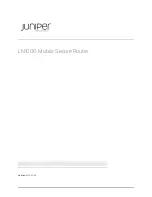
176
6620-3201
Host key #2 fi lename:
This is the
fi
lename of either an SSH V1 host key or an SSH V2 host key. It is highly recommended
that the
fi
lename be pre
fi
xed with “priv” to ensure that the key is not compromised. This key is
generated on the
Confi gure
>
Certifi cates
>
Utilities
page.
Maximum login time (secs):
This parameter speci
fi
es the maximum length of time in seconds that a user is allowed to successfully
complete the login procedure once the SSH socket has been opened. The socket is closed if the user
has not completed a successful login within this period.
Maximum login attempts:
This is the maximum number of login attempts allowed before the SSH socket will be closed.
Compression level:
SSH uses the DEFLATE compression algorithm. This parameter is used to set the desired level of
compression. Higher values may result in better compression but will require more CPU time within
the router. If the value is set to 0, compression is disabled.
V1 Options
Server key bits:
During the initialisation of an SSH session, the server sends its host key and a server key (which
should be of a different size to the host key). The unit generates this key automatically but the length
of the server key is determined by this parameter. If, when you set this value, it is too similar to the
length of the host key, the unit will automatically adjust the selected value so that the key sizes are
signi
fi
cantly different.
V2 Options
Actively start key exchange:
Some SSH clients wait for the server to initiate the key exchange process when a new SSH session is
started unless they have data to send to the server, in which case they will initiate the key exchange
themselves. If this parameter is set to “Yes”, the unit will automatically initiate a key exchange without
waiting for the client.
Rekey Kbytes:
With SSH V2 it is possible to negotiate new encryption keys after they have been used to encrypt a
speci
fi
ed amount of data. This parameter is used to specify the amount of data that passed over an
encrypted link before a new set of keys must be negotiated. When the parameter is set to 0, new keys
are not negotiated.
MAC MD5 preference (0= disabled):
MAC MD5-96 preference (0=disabled):
MAC SHA1 preference (0=disabled):
MAC SHA1-96 preference (0=disabled):
Each of the above four parameters may be used allocate a preference value to each of the
authentication methods. Each parameter, when set to a non-zero value, indicates the preference level
for that authentication parameter. The lower the value, the higher the preference level. For example,
if MAC SHA1-96 was the preferred method of authentication you would set MAC SHA1 96 to 1 and
the other parameters to 2 or more. If all of these parameters are set to the same value, the unit
automatically uses them in the following order: SHA1, SHA1-96, MD5, MD5-96.
Debug output:
If you have problems in establishing an SSH connection, this parameter may be turned on to enable
debug information about the connection to be routed to the debug port.
















































